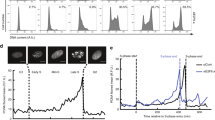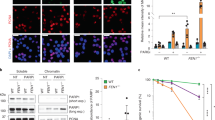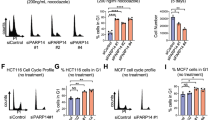Abstract
E2F-1, a transcription factor implicated in the activation of genes required for S phase such as DNA pol α, is regulated by interactions with Rb and by cell-cycle dependent alterations in E2F-1 abundance. We have shown that depletion of poly(ADP-ribose) polymerase (PARP) by antisense RNA expression downregulates pol α and E2F-1 expression during early S phase. To examine the role of PARP in the regulation of pol α and E2F-1 gene expression, we utilized immortalized mouse fibroblasts derived from wild-type and PARP knockout (PARP−/−) mice as well as PARP−/− cells stably transfected with PARP cDNA [PARP−/−(+PARP)]. After release from serum deprivation, wild-type and PARP−/−(+PARP) cells, but not PARP−/− cells, exhibited a peak of cells in S phase by 16 h and had progressed through the cell cycle by 22 h. Whereas [3H]thymidine incorporation remained negligible in PARP−/− cells, in vivo DNA replication maximized after 18 h in wild-type and PARP−/−(+PARP) cells. To investigate the effect of PARP on E2F-1 promoter activity, a construct containing the E2F-1 gene promoter fused to a luciferase reporter gene was transiently transfected into these cells. E2F-1 promoter activity in control and PARP−/−(+PARP) cells increased eightfold after 9 h, but not in PARP−/− cells. PARP−/− cells did not show the marked induction of E2F-1 expression during early S phase apparent in control and PARP−/−(+PARP) cells. RT – PCR analysis and pol α activity assays revealed the presence of pol α transcripts and a sixfold increase in activity in both wild-type and PARP−/−(+PARP) cells after 20 h, but not in PARP−/− cells. These results suggest that PARP plays a role in the induction of E2F-1 promoter activity, which then positively regulates both E2F-1 and pol α expression, when quiescent cells reenter the cell cycle upon recovery from aphidicolin exposure or removal of serum.
This is a preview of subscription content, access via your institution
Access options
Subscribe to this journal
Receive 50 print issues and online access
$259.00 per year
only $5.18 per issue
Buy this article
- Purchase on Springer Link
- Instant access to full article PDF
Prices may be subject to local taxes which are calculated during checkout






Similar content being viewed by others
Abbreviations
- PARP:
-
poly(ADP-ribose) polymerase
- MRC:
-
multiprotein DNA replication complex
- pol:
-
DNA polymerase
- PCNA:
-
proliferating cell nuclear antigen
- DMEM:
-
Dulbecco's modified Eagle's medium
- FBS:
-
fetal bovine serum
- PBS:
-
phosphate-buffered saline
- CAT:
-
chloramphenicol acetyltransferase
- RT – PCR:
-
reverse transcription-polymerase chain reaction
References
Alkhatib HM, Chen DF, Cherney B, Bhatia K, Notario V, Giri C, Stein G, Slattery E, Roeder RG and Smulson ME. . 1987 Proc. Natl. Acad. Sci. USA 84: 1224–1228.
Bambara R and Jessee C. . 1991 Biochim. Biophys. Acta 1088: 11.
Baserga R. . 1991 J. Cell Sci. 98: 433–436.
Blake M and Azizkhan J. . 1989 Mol. Cell Biol. 9: 4994–5002.
Butler A and Ordahl C. . 1999 Mol. Cell Biol. 19: 296–306.
de Murcia J, Niedergang C, Trucco C, Ricoul M, Dutrillaux B, Mark M, Oliver J, Masson M, Dierich A, LeMeur M, Waltzinger C, Chambon P and deMurcia G. . 1997 Proc. Natl. Acad. Sci. USA 94: 7303–7307.
DeGregori J, Kowalik T and Nevins J. . 1995 Mol. Cell Biol. 15: 4215–4224.
Ding R, Pommier Y, Kang VH and Smulson M. . 1992 J. Biol. Chem. 267: 12804–12812.
Ding R and Smulson M. . 1994 Cancer Res. 54: 4627–4634.
Johnson D, Cress W, Jakoi L and Nevins J. . 1994a Proc. Natl. Acad. Sci. USA 91: 12823–12827.
Johnson D, Ohtani K and Nevins J. . 1994b Genes Dev. 8: 1514–1525.
Johnson D, Schwaz J, Cress W and Nevins J. . 1993 Nature 365: 349–352.
Kannan P, Yu Y, Wankhade S and Tainsky M. . 1999 Nucl. Acids Res. 27: 866–874.
Meisterernst M, Stelzer G and Roeder R. . 1997 Proc. Natl. Acad. Sci. USA 94: 2261–2265.
Miyazawa H, Izumi M, Tada S, Takada R, Masutani M, Ui M and Hanaoka F. . 1993 J. Biol. Chem. 268: 8111–8122.
Neuman E, Flemington E, Sellers W and Kaelin W. . 1994 Mol. Cell Biol. 14: 6607–6615.
Nevins J. . 1992 Science 258: 424–429.
Pearson B, Nasheuer H and Wang T. . 1991 Mol. Cell Biol. 11: 2081–2095.
Qin X, Livingston D, Kaelin W and Adams P. . 1994 Proc. Natl. Acad. Sci. USA 91: 10918–10922.
Rawling J and Alvarez-Gonzalez R. . 1997 Biochem J. 324: 249–253.
Rosenthal DS, Shima TB, Celli G, De Luca LM and Smulson ME. . 1995 J. Invest. Dermatol. 105: 38–44.
Shieh WM, Ame JC, Wilson M, Wang ZQ, Koh D, Jacobson M and Jacobson E. . 1998 J. Biol. Chem. 273: 30069–30072.
Simbulan C, Suzuki M, Izuta S, Sakurai T, Savoysky E, Kojima K, Miyahara K, Shizuta Y and Yoshida S. . 1993 J. Biol. Chem. 268: 93–99.
Simbulan-Rosenthal CM, Rosenthal DS, Boulares AH, Hickey RJ, Malkas LH, Coll JM and Smulson ME. . 1998a Biochemistry 37: 9363–9370.
Simbulan-Rosenthal CM, Rosenthal DS, Iyer S, Boulares AH and Smulson ME. . 1998b J. Biol. Chem. 273: 13703–13712.
Simbulan-Rosenthal CMG, Rosenthal DS, Hilz H, Hickey R, Malkas L, Applegren N, Wu Y, Bers G and Smulson M. . 1996 Biochemistry 35: 11622–11633.
Slansky J, Li Y, Kaelin W and Farnham P. . 1993 Mol. Cell Biol. 13: 1610–1618.
Smulson ME, Kang VH, Ntambi JM, Rosenthal DS, Ding R and Simbulan CMG. . 1995 J. Biol. Chem. 270: 119–127.
Sukhorukov V, Djuzenova C, Arnold W and Zimmermann U. . 1994 J. Membrane Biol. 142: 77–92.
Tom T, Hickey R and Malkas L. . 1996 J. Cell. Biochem. 63: 259–267.
Vindelov LL, Christensen IJ and Nissen NI. . 1983 Cytometry 3: 323–327.
Waga S and Stillman B. . 1994 Nature 369: 207–212.
Wang ZQ, Auer B, Stingl L, Berghammer H, Haidacher D, Schweiger M and Wagner EF. . 1995 Genes Dev. 9: 509–520.
Weinberg R. . 1995 Cell 81: 323–330.
Wong S, Paborsky L, Fisher P, Wang TS-F and Korn D. . 1986 J. Biol. Chem. 261: 7958–7968.
Acknowledgements
Authors thank Dr ZQ Wang (IARC, Lyon, France) for the immortalized wild-type and PARP−/− cells, Dr William G Kaelin (Dana Farber Cancer Inst., Boston, MA, USA) for the E2F-1 promoter – luciferase construct (pGl2), and Dr Owen Blair (Cell Cycle Core Facility, Lombardi Cancer Center) for help with the flow cytometry. This work was supported by grants (CA25344 and PO1 CA74175) to ME Smulson from the National Cancer Institute, the U.S. Air Force Office of Scientific Research (AFOSR-89-0053) to ME Smulson and the U.S. Army Medical Research and Development Command contract DAMD17-90-C-0053 to ME Smulson and DAMD17-96-C-6065 to DS Rosenthal.
Author information
Authors and Affiliations
Rights and permissions
About this article
Cite this article
Simbulan-Rosenthal, C., Rosenthal, D., Luo, R. et al. Poly(ADP-ribose) polymerase upregulates E2F-1 promoter activity and DNA pol α expression during early S phase. Oncogene 18, 5015–5023 (1999). https://doi.org/10.1038/sj.onc.1202900
Received:
Revised:
Accepted:
Published:
Issue Date:
DOI: https://doi.org/10.1038/sj.onc.1202900



